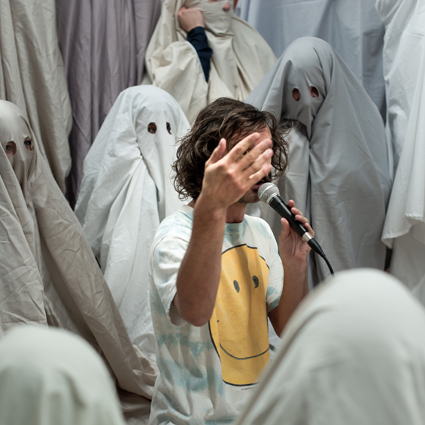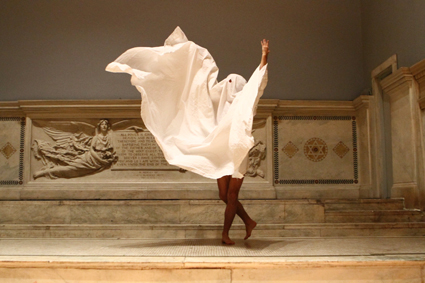Ghosts of presences past
Rennie McDougall, Luke George interview

Luke George and audience, Not About Face showing at West Space
photo Rohan Young
Luke George and audience, Not About Face showing at West Space
Last year I saw a show in New York, wherein two performers re-enacted a famous 1963 interview between Martha Graham and critic Walter Terry. Richard Move, who played Martha, has devoted his entire stage career to immortalising Graham through imitation. Unlike other drag manifestations, Move’s Graham is an utterly faithful non-parodic transformation. He thoroughly inhabits Graham’s boldly constructed persona in all its detail, as well as displaying the same discipline and emotive conviction evident in her choreographies.
In the interview, ‘Graham’ speaks of how when performing she is “possessed” by the character she is playing, its spirit taking hold of her bodily vessel and expressing itself through her in the moment of performance. As we hear this we are witnessing the same magic occur through Richard Move, an incarnation that is explicitly an imposter ‘possessed.’ In the words of Move in the words of Martha Graham, “First we have to believe, and then we believe.”
Melbourne-based choreographer and performer Luke George proposes something attuned to this concept of channelling past performers in his new project Not About Face: “We will come together, we will become anonymous, we will fake belief and believe in faking it.”
George recently presented Not About Face for Dance Massive’s Open Studio program as a work-in-progress, wherein the audience enters a rehearsal studio like cheap Halloween ghosts, donning bedsheets with eyeholes cut out (I had a fitted sheet, all the more domestic). Under the sheet I become an insular entity, aware of my presence but transformed into obscurity. Each of us is now a wraith, an anonymous self. Without seats or a marked performance area we are left to negotiate our proximity to the performance and each other.
George, at first unidentifiable from the rest of us ‘ghosts,’ eventually emerges to claim his presence as shepherd to our flock. Once revealed he undergoes a series of transformations: channelling deceased performers, communing with a past version of himself through a television set and guiding us into summoning incantations of colour, to name a few. Between performative acts George speaks to us as himself, casually and directly, making explicit that this is all authentically pretend.

Luke George, Not About Face, New York
photo Alex Escalante
Luke George, Not About Face, New York
Speaking about his latest work, George explains “I act as a medium.” In one instance he re-enacts a recording of a woman acting as a medium for a 35,000-year-old prophet. George’s act as medium however is (like any ghost) more transparent. “I just use headphones, and you can see my iPod and it’s completely visible.” We see this process in action made explicit—the paradoxical truth of the pretending.
Performance has entertained a long history of spiritual summoning, ranging from the devout to the kitsch. People tend towards one of two responses to such spiritual experiences—belief or scepticism, both of which act only to close off possibilities. The space between knowing and not is where George chooses to operate. “I don’t have a position on whether I’m a sceptic or whether I’m a believer, I am more comfortable just to explore it without having to make a decision one way or the other…to be in a question state and to pursue that question.” Once acknowledged that Not About Face is an act of ‘fake-belief,’ the concept of ‘spirit’ then takes on much more complex possibilities.
For George this interest in “evoking other bodies in this time, or in another time” comes from a desire to understand what motivates the body’s impulses in choreography. As a dance artist interested in improvisation, influenced by his recent collaborations with New York artists Miguel Gutierrez and Hilary Clark, he is engaging with choreographies that aren’t restrictively pre-conceived—the performance unfolds in the moment of its happening. This leads to the question “What is the source of the physical information at the moment of articulation?” and then, for George, “Who else is contained in my body? Is it just me?”
All bodies carry histories, and they are always performing these histories. This becomes all the more specific for the dancer’s body that has absorbed unique languages of movement from past teachers and choreographers, the traces of which remain present long after. These physical manifestations may reveal themselves consciously or unconsciously each time a performer is in action. In a history of performance, one that by its very nature erases tangible traces, we can imagine the bodies of the present are something of a vessel to the past, whereby we witness past physical resonances simply by observing the performing body in action.
George reminds me that our minds are programmed to activate “80% of the synaptic responses that occur when performing [an action]” simply by observing it, allowing us a particular and unique “capacity for empathy because of action.” His interest in movement as “a presence that you can’t see” reveals less a superstitious inclination than his embrace of the unique quality of an empathetic visceral experience before it is a visual one.
When George recently participated in Open Studios it was in a rehearsal studio, not a theatre. He has also explored the possibilities in Not About Face through public encounters at Westspace gallery, The Meat Market and at Movement Research, Judson Church in New York at different stages of development, each space carrying with it a different set of expectations from audiences.
A traditional theatre, with its many design elements, is a space that dance-makers sometimes need to distance themselves from in order to highlight the cognitive transmission of bodily information. In George’s somewhat ordinary studio setting, there’s very little smoke-and-mirrors to entice you into any fantasy version of spirituality. With few visual cues, personal imaginative space is given permission to muse on complex ideas, to entertain the possibilities of the unseeable elements of performance. Luke George’s offer is a generous invitation to both actively inhabit the pretend while internally freely conjuring your own experience, seeing it through the eyes of your homemade ‘spirit.’
Luke George and Collaborators, Not About Face, 9-13 Oct, Dancehouse, Melbourne
RealTime issue #115 June-July 2013 pg. 33






